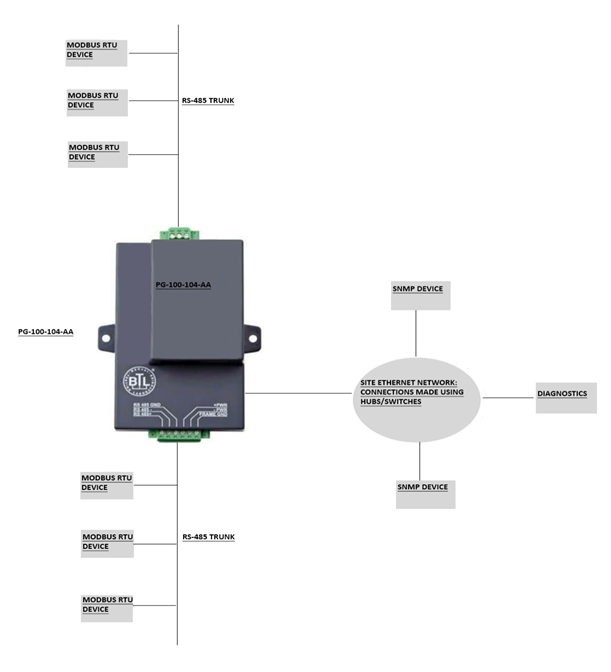PG-100-104-AA is highly powerful, superior, completely configurable and productive Building & Industrial Automation gateway for integrators to effortlessly interface devices to networks in commercial buildings and industrial plants.
PG-100-104-AA Gateway model supports Modbus RTU and SNMP protocols. It is a Bi-directional Converter that can be configured as a Client and/or a Server on either protocol interface.
When configured as a SNMP client, the PG-100-104-AA can read data from your SNMP devices and publish it as Modbus RTU data. Also, it can write commands sent from the Modbus RTU side to the SNMP devices.
When configured as a Modbus RTU client, the PG-100-104-AA can read data from your Modbus RTU devices and publish it as SNMP data. Also, it can write commands sent from the SNMP side to the Modbus RTU devices.
The PG-100-104-AA can be configured to behave as a server on both SNMP and Modbus RTU interfaces. This mode is useful when data exchange is required between a SNMP client (for eg. SCADA) and a BACnet IP client (for eg. a Building Management System).
PG-100-104-AA can be configured to behave as a client on both SNMP and Modbus RTU interfaces.
PG-100-104-AA gateways have benefitted system integrators worldwide with its powerful line of gateways. Additionally, PG-100-104-AA gateway runs the same protocol conversion software on a productive and cost efficient platform backed by the experience, engineering expertise and technically proven support that integrators have come to expect from PG-100-104-AA.
Key Features
- Ability to interface up to 1000 points of common BAS protocols
- 2xRS 485 Ports, 1xEthernet Port
- BTL Mark – PG-10XX Series
- LonMark Certified – PG-10XX Series
- BACnet COV support for fast data communication while reducing traffic over a BACnet network
- Multi-configuration capability; specific configurations selectable via DIP switches or software
- Flat panel mount standard, DIN rail mount option
- DIP switches to select baud rate or node ID on the fly

Scenario 1
- There are several Schneider Ion meters on the site which provide data output on Modbus RTU.
- The site has a building management system on SNMP that needs the energy data from Schneider ion meters.
- A direct exchange of data between Schneider ion meters and building management system is not possible as the Schneider Ion meters provide data output on Modbus RTU and building management system understands SNMP only.
Solution
- The devices can directly communicate with each other only if they are on the same protocol. Modbus RTU is a Serial protocol, while SNMP is an Ethernet based protocol. Hence, a converter is needed that will convert the data from SNMP device to Modbus RTU and vice versa.
- PG-100-104-AA Modbus RTU to SNMP converter is an excellent solution to this requirement. This helps the gateway in reading the data from the Energy meters on Modbus RTU and it caches this data internally and then provides it on SNMP when requested from the Building management system.
Scenario 2
- There are PAC units on the other site which provide data output on SNMP.
- The site has a PLC on Modbus RTU that needs the temperature data from PAC units on SNMP.
- A direct exchange of data between PAC units and PLC is not possible as the PAC units provide data output on SNMP and the PLC understands Modbus RTU only.
Solution
- The devices can directly communicate with each other only if they are on the same protocol. Modbus RTU is a Serial protocol, while SNMP is an Ethernet based protocol. Hence, a converter is needed that will convert the data from SNMP device to Modbus RTU and vice versa.
- PG-100-104-AA Modbus RTU to SNMP converter is an excellent solution to this requirement. This helps the gateway in reading the data from the PAC units on SNMP and it caches this data internally and then provides it on Modbus RTU when requested from the PLC.
Outline of Modbus RTU and SNMP
Modbus RTU
Modbus RTU is a serial communication protocol that connects different devices on the same network and would make the communication between them possible.
Modbus is transmitted over serial lines between devices. The cables used for the connection are either RS-485 or RS-232 cables. The simplest setup would be a single serial cable connecting the serial ports on two devices, a Master and a Slave.
The data is sent as series of ones and zeroes called bits. Each bit is sent as a voltage. Zeroes are sent as positive voltages and ones as negative. The bits are sent very quickly. A typical transmission speed is 9600 baud (bits per second).
SNMP:
Simple Network Management Protocol (SNMP) was originally made for the management of devices such as switches and routers, its usage has grown so much nowadays that it is used for monitoring of nearly any electronic device one can think of. It is a protocol which is majorly designed to manage networked devices from a single-central location. SNMP is now used to monitor and manage television broadcast studios, airborne military platforms, automated fare collection systems, emergency radio networks, energy distribution systems, and much more. Microsoft Windows Server 2003 provides SNMP agent software that works with third-party SNMP management software to monitor the status of managed devices and applications.
How to configure the PG-100-104-AA gateway?
- We will configure the gateway for you based on your requirement and support you during commissioning of the gateway, so you do not have to worry about configuring the PG-100-104-AA gateway.
- However, it is very helpful to know how to configure the devices. All the required tools and supporting product manuals with be provided completely free of cost with your purchase.
- Configuration of the PG-100-104-AA is done using a ‘.csv’ file. This file can be edited using any text editor (example Microsoft excel).
- In this file we need to enter information for the Client and Server side interfaces of the PG-100-104-AA. This includes but is not limited to
- Node ids of the slave devices
- IP addresses/device address of the slave devices
- Baud rate, parity, stop bits for serial communication
- Scan rates
- And finally we need to create an internal mapping that would map each data value read on the client side to a data value on the server side.
- For detailed information on configuration please get in touch with us and review the configuration manual on top of this page.
